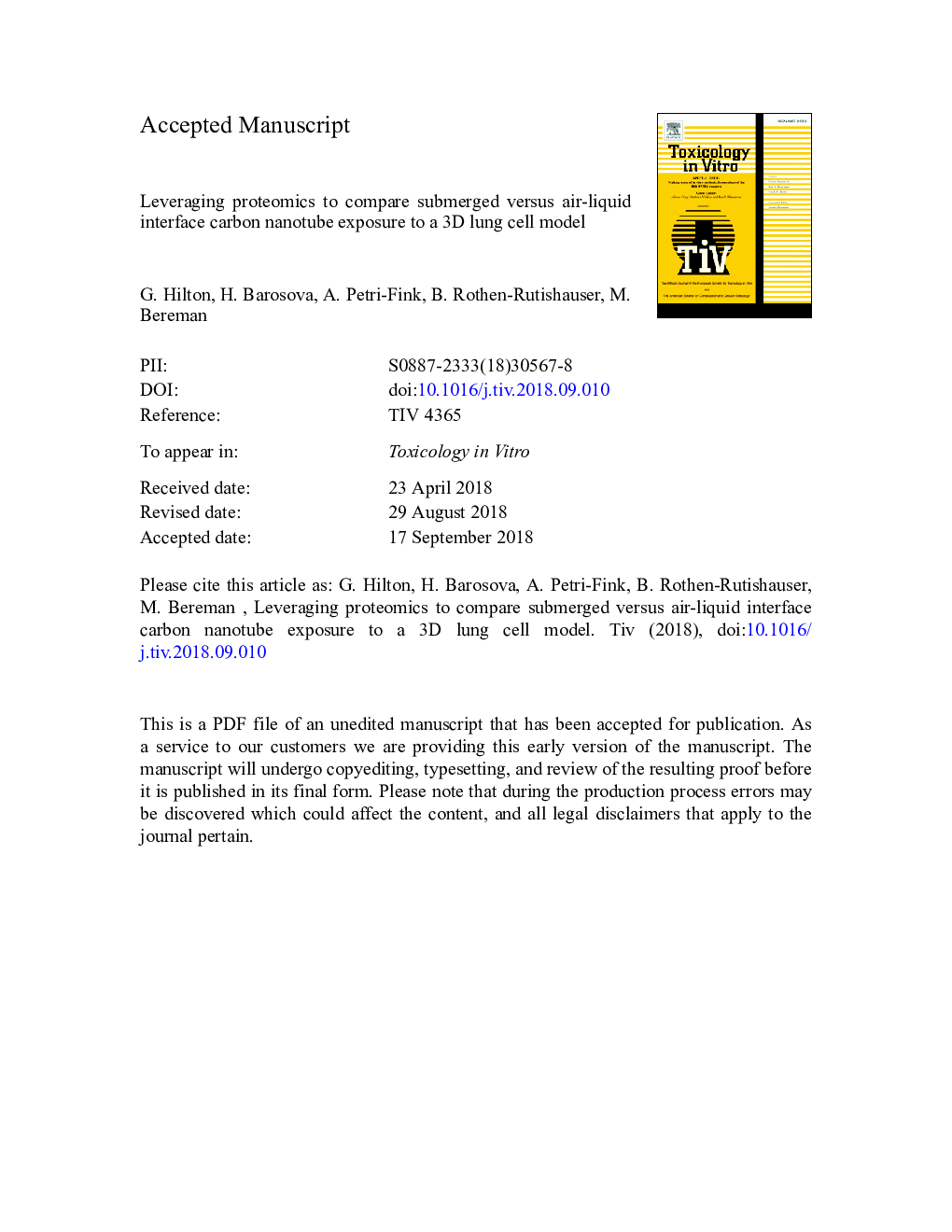| کد مقاله | کد نشریه | سال انتشار | مقاله انگلیسی | نسخه تمام متن |
|---|---|---|---|---|
| 11025644 | 1666540 | 2019 | 39 صفحه PDF | دانلود رایگان |
عنوان انگلیسی مقاله ISI
Leveraging proteomics to compare submerged versus air-liquid interface carbon nanotube exposure to a 3D lung cell model
ترجمه فارسی عنوان
استفاده از پروتئومیک برای مقایسۀ قرارگیری نانولوله کربنی زیر آب در مقابل مایع هوا در برابر مدل سلولی ریه
دانلود مقاله + سفارش ترجمه
دانلود مقاله ISI انگلیسی
رایگان برای ایرانیان
کلمات کلیدی
ToxicoproteomicsMWCNTsCNTSNIEHSDDATCCCIPABSA - BSALC-MS/MS - LC-MS / MSbovine serum albumin - آلبومین سرم گاوAli - اماIngenuity Pathway Analysis - تجزیه و تحلیل راه IngenuityNational Institute of Environmental Health Sciences - موسسه ملی علوم بهداشت محیطMulti-walled carbon nanotubes - نانولوله های کربنی چند دیوارهCarbon nanotubes - نانولولههای کربنیair-liquid Interface - هوا مایع رابطLabel-free proteomics - پروتئومیک بدون برچسبliquid chromatography tandem mass spectrometry - کروماتوگرافی مایع اسپکترومتری دو طرفهhigh-performance liquid chromatography - کروماتوگرافی مایعی کاراHPLC - کروماتوگرافی مایعی کاراData Dependent Acquisition - کسب وابستگی به داده ها
موضوعات مرتبط
علوم زیستی و بیوفناوری
علوم محیط زیست
بهداشت، سم شناسی و جهش زایی
چکیده انگلیسی
With the emerging concern over the potential toxicity associated with carbon nanotube inhalation exposure, several in vitro methods have been developed to evaluate cellular responses. Since the major concern for adverse effects by carbon nanotubes is inhalation, various lung cell culture models have been established for toxicity testing, thus creating a wide variation of methodology. Limited studies have conducted side-by-side comparisons of common methods used for carbon nanotube hazard testing. The aim of this work was to use proteomics to evaluate global cellular response, including pro-inflammatory and pro-fibrotic mediators, of a 3D lung model composed of macrophages, epithelial cells, and fibroblasts which mimics the human alveolar epithelial tissue barrier. The cells were exposed to Mitsui 7 (M-7) multi-walled carbon nanotubes (MWCNT) under submerged and air-liquid interface (ALI) conditions and discovery proteomics identified 3500 proteins. The M-7 ALI exposure compared to control was found to increase expression in proteins related to oxidative stress that were not found to be enriched in submerged exposure. Comparison of MWCNT exposure methods, M-7 ALI exposure versus M-7 submerged exposure, yielded protein enrichment in pathways known to be associated with carbon nanotube exposure stress response, such as acute phase response signaling and NRF2-mediated oxidative stress response. This study demonstrates a comparison of commonly deployed carbon nanotube exposure methods. These data should be considered by the nanotoxicology community when interpreting or cross comparing in vitro exposure results.
ناشر
Database: Elsevier - ScienceDirect (ساینس دایرکت)
Journal: Toxicology in Vitro - Volume 54, February 2019, Pages 58-66
Journal: Toxicology in Vitro - Volume 54, February 2019, Pages 58-66
نویسندگان
G. Hilton, H. Barosova, A. Petri-Fink, B. Rothen-Rutishauser, M. Bereman,
